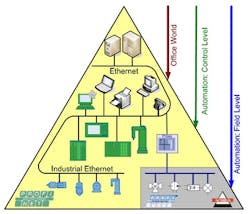How to Use Ethernet to Connect Control and IT
In most companies, the days of operating automation and controls as isolated systems are long past. For a number of years, automation components such as controllers and control PCs have been communicating with centralized computers and servers. These centralized computers are normally located in centralized network areas, same as in the Information Technology (IT) world, and must therefore be accessible via the network administered by IT personnel.In addition, more and more automation system components, such as IO devices, valves, and drives, are connected to controlling components via Ethernet. Due to this trend, the use of Ethernet is becoming more and more common for connecting field-level devices. The great number of Ethernet-linked automation devices requires rethinking network structures.The new PI whitepaper, PROFINET and IT, describes the fundamental differences of the automation and IT network worlds and illustrates the principles for integrating Ethernet-based automation communication into an overall network that is also used for office, telecommunication and building environments. Click here to download the paper now. Executive SummaryPROFINET, a market-leading Industrial Ethernet protocol, encompasses all levels of a network, ranging from the physical infrastructure to the Ethernet network access layer and the TCP/IP layer and finally to the application layer. The structures and topologies of conventional network technology used in IT and in automation differ only in the machine-level area of the automation system; the superordinate levels of the network are essentially identical. As a result, PROFINET can be easily integrated into existing network environments.The integration or connection of automation areas does not affect the superordinate network communication to any significant degree because the data traffic, which is mainly cyclical in nature, is predominantly limited to local data traffic. Increasingly, communication with centralized devices is becoming necessary, but this constitutes neither the major portion of the automation applications nor the major portion of the superordinate network. The communication demands of automation do not require faster data transmission rates on the overall network. In this regard, the PROFINET-generated communication can be categorized the same as any other additional application.Like Office applications, PROFINET applications use the TCP/IP protocol and IP services. Depending on the number of automation areas to be integrated, the number of IP subnets to be addressed within the overall network can increase significantly. This necessitates use of a comprehensive address concept for office and automation areas, which also takes into consideration the use of private IP addresses, if applicable.PROFINET allows applications with a wide range of different realtime requirements to be implemented. In the automation environment, realtime requirements exceeding those specified in the multimedia environment must often be met. PROFINET satisfies these specific requirements by adapting different realtime scenarios in which, however, communication still remains limited to the machine level, i.e., in one logical subnet and in one broadcast domain, so that no special preparation of the superordinate network is necessary.Passive and active PROFINET components meet all requirements anticipated in harsh industrial environments. However, these unfavorable environments cannot be assumed as the blanket condition for all types of communication in industry, and as a result components suitable for IT use can also be considered up to a certain point. In terms of cabling, the international standards have been expanded for industrial cabling. However, these standards do not necessarily apply at the machine level. The specific cabling standards in the PROFINET specifications must be considered there.As long as the data communication occurs independently within the automation cells, the availability of the superordinate network plays no crucial role here. Specific measures for increasing the availability are not necessary. The availability within the automation cells themselves can be improved by taking suitable measures. For example, components with a longer lifetime and with simplified replacement and repair possibilities can be used. Redundancy mechanisms can also be introduced.The operation of automation systems is dominated by the requirement of simplicity. In addition to simple options for replacement and configuration, PROFINET also provides comprehensive diagnostics. In addition, it is possible to link to the central SNMP management of the overall network in order to monitor the network technology.A significant technical challenge associated with introduction of PROFINET is related to the separation or connection of the IT world and the automation world. Security and operation aspects, among other factors, play a large role here when planning the overall network.Click here to download the complete whitepaper.

